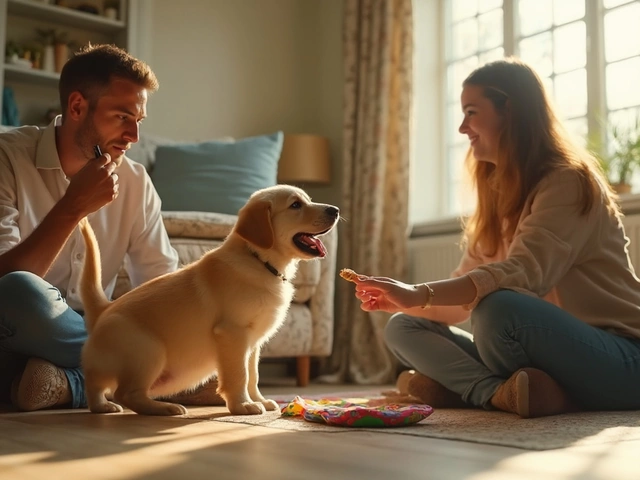So your dog barks too much. Maybe it’s at the mail carrier, the neighbor’s cat, or just because they’re bored. You’ve seen those electronic bark collars on the shelf-shock, vibration, or spray-and wondered if they’re the answer. But something inside you says no. You don’t want to scare your dog. You don’t want to hurt them. You want to fix the problem, not punish the symptom.
Good news: there are better ways. And they actually work.
Bark collars don’t teach dogs why not to bark. They just make barking painful or unpleasant. That might stop the noise for a while, but it doesn’t fix the root cause. Dogs bark for reasons-fear, boredom, excitement, territorial instincts. If you silence the bark without addressing the reason, you’re just suppressing a symptom. And that often leads to bigger problems down the line: anxiety, avoidance, even aggression.
Understand Why Your Dog Barks
Before you reach for any tool, ask yourself: why is my dog barking right now?
- Alarm barking-they see someone at the door, hear a noise, spot a squirrel. This is natural. Dogs are watchdogs.
- Attention-seeking-they bark because it gets you to look up, talk to them, or give them food.
- Separation anxiety-they bark when left alone. This isn’t defiance. It’s panic.
- Boredom-no mental or physical stimulation? They’ll create their own noise.
- Compulsive barking-repetitive, almost robotic barking with no trigger. This needs professional help.
Once you know the reason, you can pick the right fix. A shock collar won’t help a lonely dog. But a long walk and a puzzle toy might.
Use Positive Reinforcement Training
This is the gold standard. It’s not magic. It’s science. Dogs repeat behaviors that get rewarded.
Here’s how it works for barking:
- Wait for a quiet moment-even if it’s just two seconds of silence.
- Right when they stop barking, say “quiet” in a calm voice and give them a treat.
- Repeat this every time they pause.
- Gradually increase the length of silence before rewarding.
After a few days, your dog will start to associate silence with rewards. They’ll learn that being quiet gets them what they want-food, attention, praise-instead of barking.
Use high-value treats at first: small pieces of chicken, cheese, or freeze-dried liver. Once the behavior sticks, you can phase out treats and use praise or a toy instead.
This method works for most dogs-even those who bark nonstop. It takes patience, but it builds trust, not fear.
Redirect With Toys and Activities
Boredom is one of the biggest triggers for excessive barking. If your dog has nothing to do, they’ll make noise.
Try these simple fixes:
- Food puzzles-Kong toys stuffed with peanut butter or wet food keep dogs busy for 20-30 minutes.
- Chew bones-rawhide alternatives like bully sticks or antlers satisfy the urge to gnaw.
- Fetch or tug-a 15-minute play session before you leave the house can tire them out enough to nap.
- Sniffing games-hide treats around the house or yard and let them find them. Dogs love using their noses.
One client in Auckland had a Border Collie who barked nonstop while she worked from home. She started leaving a frozen Kong stuffed with yogurt and banana every morning. Within a week, the barking dropped by 80%. The dog wasn’t punished. He was just busy.

Desensitize to Triggers
If your dog barks at the doorbell, the mail truck, or people walking by the window, you can train them to be calmer.
Here’s how:
- Record the trigger sound (doorbell, car horn, etc.) on your phone.
- Play it at a very low volume while your dog is calm.
- As soon as they notice the sound but don’t bark, give them a treat.
- Slowly increase the volume over several days.
- If they bark, stop the sound and try again at a lower volume.
This is called counter-conditioning. You’re changing how your dog feels about the trigger. Instead of seeing the doorbell as a threat, they learn it means treats are coming.
Do this daily for 5-10 minutes. It takes time, but it’s one of the most effective long-term solutions.
Use a Citronella Spray Collar (If You Must)
Not all bark collars are created equal. If you’ve tried everything else and still need a tool, consider a citronella spray collar.
Unlike shock collars, these release a puff of harmless, citrus-scented spray when your dog barks. Most dogs dislike the smell and stop barking to avoid it.
But here’s the catch: it still doesn’t teach them why not to bark. It just interrupts the behavior.
Use it as a temporary aid, not a solution. Pair it with positive training. For example, reward silence right after the spray stops. That way, your dog learns that quiet = good, not just “spray = bad.”
Look for collars with adjustable sensitivity and auto-shutoff features. Avoid ones that spray constantly or don’t turn off after a few barks.
Try a Dog Appeasing Pheromone Diffuser
These aren’t magic, but they help-especially for anxiety-related barking.
Products like Adaptil release synthetic pheromones that mimic the calming scent mother dogs give off to their puppies. They’re odorless to humans but can soothe stressed dogs.
Plug one into the room where your dog spends the most time. Use it daily for at least a month. Many owners report less pacing, less whining, and quieter nights.
It won’t fix barking caused by boredom or attention-seeking. But if your dog is nervous, lonely, or scared, this can be a gentle support tool.

Get Professional Help
If your dog barks nonstop, seems anxious, or reacts aggressively, don’t wait. Talk to a certified dog trainer or veterinary behaviorist.
Look for trainers who use force-free methods. Ask if they’re certified by the International Association of Animal Behavior Consultants (IAABC) or CCPDT. Avoid anyone who says “dominance” or “alpha” or recommends shock collars as a first step.
Some vets offer behavior consultations. They can rule out medical issues-like hearing loss or thyroid problems-that can cause excessive barking.
One dog in Wellington was diagnosed with early-onset cognitive dysfunction. Once his owner started giving him a daily supplement and a consistent routine, his barking dropped by 90%. No collar needed.
What Not to Do
Here’s what doesn’t work-and often makes things worse:
- Yelling “quiet!”-you’re just adding more noise. Your dog hears it as joining the chorus.
- Ignoring all barking-if your dog barks for attention, ignoring them might work. But if they’re scared or in pain, ignoring them is cruel.
- Using shock or ultrasonic collars-these cause stress, fear, and sometimes aggression. Many countries, including New Zealand, restrict or ban them.
- Pruning their vocal cords-this surgery is inhumane and illegal in many places. It doesn’t fix behavior. It just makes your dog unable to communicate.
There’s no shortcut that’s both kind and effective. The only path that lasts is understanding.
Real Results: A 30-Day Plan
Here’s a simple plan you can start today:
- Days 1-7: Track when and why your dog barks. Write it down. Look for patterns.
- Days 8-14: Start positive reinforcement. Reward 3 seconds of silence with a treat.
- Days 15-21: Add a daily 20-minute walk and a food puzzle.
- Days 22-30: Begin desensitization to one trigger (e.g., doorbell).
By day 30, most owners see a 50-80% reduction in barking. Not because they silenced their dog-but because they taught them something better.
It’s not about stopping the bark. It’s about giving your dog a reason to be calm.





